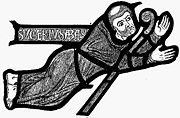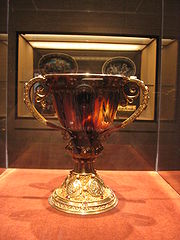
Abbot Suger
Encyclopedia

Franks
The Franks were a confederation of Germanic tribes first attested in the third century AD as living north and east of the Lower Rhine River. From the third to fifth centuries some Franks raided Roman territory while other Franks joined the Roman troops in Gaul. Only the Salian Franks formed a...
abbot-statesmen, an historian, and the influential first patron of Gothic architecture
Gothic architecture
Gothic architecture is a style of architecture that flourished during the high and late medieval period. It evolved from Romanesque architecture and was succeeded by Renaissance architecture....
.
Suger's family origins are unknown. Several times in his writings he suggests that his was a humble background, though this may just be a topos
Literary topos
Topos , in Latin locus , referred in the context of classical Greek rhetoric to a standardised method of constructing or treating an argument. See topos in classical rhetoric...
or convention of autobiographical writing. In 1091, at the age of ten, Suger was given as an oblate
Oblate (religion)
An oblate in Christian monasticism is a person who is specifically dedicated to God or to God's service. Currently, oblate has two meanings:...
to the abbey of St. Denis, where he began his education. He trained at the priory of Saint-Denis de l'Estrée, and there first met the future king Louis VI of France
Louis VI of France
Louis VI , called the Fat , was King of France from 1108 until his death . Chronicles called him "roi de Saint-Denis".-Reign:...
. From 1104 to 1106, Suger attended another school, perhaps that attached to the abbey of Saint-Benoît-sur-Loire
Saint-Benoît-sur-Loire
Saint-Benoît-sur-Loire is a commune in the Loiret department in north-central France.This town hosts the Abbaye de Fleury, also known as the Abbaye de Saint Benoît . Founded around 630, it is one of the oldest abbeys of the Benedictine rule...
. In 1106 he became secretary to the abbot
Abbot
The word abbot, meaning father, is a title given to the head of a monastery in various traditions, including Christianity. The office may also be given as an honorary title to a clergyman who is not actually the head of a monastery...
of Saint-Denis. In the following year he became provost of Berneval
Berneval-le-Grand
Berneval-le-Grand is a commune in the Seine-Maritime department in the Haute-Normandie region in northern France.-Geography:A farming village in the Pays de Caux, situated on the cliff-lined coast of the English Channel some northeast of Dieppe, at the junction of the D54 and D113...
in Normandy
Normandy
Normandy is a geographical region corresponding to the former Duchy of Normandy. It is in France.The continental territory covers 30,627 km² and forms the preponderant part of Normandy and roughly 5% of the territory of France. It is divided for administrative purposes into two régions:...
, and in 1109 of Toury. In 1118, Louis VI sent Suger to the court of Pope Gelasius II
Pope Gelasius II
Pope Gelasius II , born Giovanni Caetani , was pope from January 24, 1118 to January 29, 1119.-Biography:He was born between 1060 and 1064 at Gaeta into the Pisan branch of the Caetani family....
at Maguelonne (at Montpellier
Montpellier
-Neighbourhoods:Since 2001, Montpellier has been divided into seven official neighbourhoods, themselves divided into sub-neighbourhoods. Each of them possesses a neighbourhood council....
, Gulf of Lyon), and he lived from 1121 to 1122 at the court of Gelasius's successor, Calixtus II.
On his return from Maguelonne, Suger became abbot of St-Denis. Until 1127, he occupied himself at court mainly with the temporal affairs of the kingdom, while during the following decade he devoted himself to the reorganization and reform of St-Denis. In 1137, he accompanied the future king, Louis VII
Louis VII of France
Louis VII was King of France, the son and successor of Louis VI . He ruled from 1137 until his death. He was a member of the House of Capet. His reign was dominated by feudal struggles , and saw the beginning of the long rivalry between France and England...
, into Aquitaine
Aquitaine
Aquitaine , archaic Guyenne/Guienne , is one of the 27 regions of France, in the south-western part of metropolitan France, along the Atlantic Ocean and the Pyrenees mountain range on the border with Spain. It comprises the 5 departments of Dordogne, :Lot et Garonne, :Pyrénées-Atlantiques, Landes...
on the occasion of that prince's marriage to Eleanor of Aquitaine
Eleanor of Aquitaine
Eleanor of Aquitaine was one of the wealthiest and most powerful women in Western Europe during the High Middle Ages. As well as being Duchess of Aquitaine in her own right, she was queen consort of France and of England...
, and during the Second Crusade
Second Crusade
The Second Crusade was the second major crusade launched from Europe. The Second Crusade was started in response to the fall of the County of Edessa the previous year to the forces of Zengi. The county had been founded during the First Crusade by Baldwin of Boulogne in 1098...
served as one of the regents of the kingdom (1147–1149). He bitterly opposed the king's divorce, having himself advised the marriage. Although he disapproved of the Second Crusade, he himself, at the time of his death, had started preaching a new crusade.

Saint Denis Basilica
The Cathedral Basilica of Saint Denis is a large medieval abbey church in the commune of Saint-Denis, now a northern suburb of Paris. The abbey church was created a cathedral in 1966 and is the seat of the Bishop of Saint-Denis, Pascal Michel Ghislain Delannoy...
built in the nascent Gothic style. Suger wrote extensively on the construction of the abbey in Liber de Rebus in Administratione sua Gestis, Libellus Alter de Consecratione Ecclesiae Sancti Dionysii, and Ordinatio. In the 1940s, the prominent art-historian Erwin Panofsky
Erwin Panofsky
Erwin Panofsky was a German art historian, whose academic career was pursued mostly in the U.S. after the rise of the Nazi regime. Panofsky's work remains highly influential in the modern academic study of iconography...
claimed that the theology of Pseudo-Dionysius the Areopagite
Pseudo-Dionysius the Areopagite
Pseudo-Dionysius the Areopagite, also known as Pseudo-Denys, was a Christian theologian and philosopher of the late 5th to early 6th century, the author of the Corpus Areopagiticum . The author is identified as "Dionysos" in the corpus, which later incorrectly came to be attributed to Dionysius...
influenced the architectural style of the abbey of St. Denis, though later scholars have argued against such a simplistic link between philosophy and architectural form. Similarly the assumption by 19th century French authors that Suger was the 'designer' of St Denis (and hence the 'inventor' of Gothic architecture) have been almost entirely discounted by more recent scholars. Instead he is generally seen as having been a bold and imaginative patron who encouraged the work of an innovative (but now unknown) master mason.
Suger became the foremost historian of his time. He wrote a panegyric on Louis VI (Vita Ludovici regis), and collaborated in writing the perhaps more impartial history of Louis VII (Historia gloriosi regis Ludovici). In his Liber de rebus in administratione sua gestis, and its supplement Libellus de consecratione ecclesiae S. Dionysii, he treats of the improvements he had made to St Denis, describes the treasure of the church, and gives an account of the rebuilding. Suger's works served to imbue the monks of St Denis with a taste for history and called forth a long series of quasi-official chronicles.
A chalice
Chalice (cup)
A chalice is a goblet or footed cup intended to hold a drink. In general religious terms, it is intended for drinking during a ceremony.-Christian:...
once owned by Suger is now in the collections of the National Gallery of Art
National Gallery of Art
The National Gallery of Art and its Sculpture Garden is a national art museum, located on the National Mall between 3rd and 9th Streets at Constitution Avenue NW, in Washington, DC...
in Washington, D.C.
Washington, D.C.
Washington, D.C., formally the District of Columbia and commonly referred to as Washington, "the District", or simply D.C., is the capital of the United States. On July 16, 1790, the United States Congress approved the creation of a permanent national capital as permitted by the U.S. Constitution....
Further reading
- Suger, Abbot of Saint Denis,. The Deeds of Louis the Fat. Translated with introduction and notes by Richard Cusimano and John Moorhead. Washington, DC : Catholic University of America PressCatholic University of America PressThe Catholic University of America Press, also known as CUA Press, is the academic publishing house of the Catholic University of America. Founded on November 14, 1939, and incorporated on July 16, 1941, the Press is a founding member of the Association of American University Presses...
,1992. (ISBN 0-8132-0758-4) - Suger, Abbot of Saint Denis,. The Deeds of Louis the Fat. Translated by Jean Dunbabin (Free, but has no annotations)

